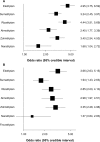A review of the pharmacoeconomics of eletriptan for the acute treatment of migraine
- PMID: 25624770
- PMCID: PMC4296958
- DOI: 10.2147/IJGM.S73673
A review of the pharmacoeconomics of eletriptan for the acute treatment of migraine
Abstract
Migraine is a commonly occurring, chronic disorder that can cause significant disability. Eletriptan, a selective serotonin 5-hydroxytryptamine 1 receptor subtype B/D (5-HT1B/1D) agonist, is a clinically effective treatment for moderate to severe migraine. The objective of this literature review was to summarize the available data on the pharmacoeconomics of eletriptan relative to other triptans. Articles meeting the following three criteria were included in the review: 1) contained pharmacoeconomic data on a marketed dose of eletriptan; 2) included data on at least one other comparator triptan; and 3) was in English. A MEDLINE(®) search yielded a total of eight studies (from the European Union [n=5] and from the USA [n=3]) across multiple regions. Seven of the studies examined the pharmacoeconomics of eletriptan relative to other triptans, and a further study examined the health care costs of eletriptan 40 mg versus sumatriptan 100 mg. Eletriptan 40 mg was among a group of triptans, including rizatriptan 10 mg and almotriptan 12.5 mg, demonstrating the greatest cost-effectiveness. This result held across different definitions of efficacy (2 hours pain-free, sustained pain-free, and sustained pain-free with no adverse events) and also held when cost-effectiveness models accounted for second doses and use of rescue medication, management of adverse events, and productivity loss, in addition to drug acquisition costs. Only limited head-to-head comparator data were available. The majority of pharmacoeconomic studies utilized the same set of efficacy and/or tolerability data, and indirect costs were rarely included despite the fact that the majority of per capita migraine costs are attributable to indirect costs. In summary, although the market is now dominated by generics, eletriptan 40 mg is among the most clinically and cost-effective oral triptans available for the management of acute migraine. Increased effectiveness/efficacy of eletriptan may necessitate a lesser need for other migraine treatments and/or switching to other triptans.
Keywords: cost-effectiveness; literature search; oral triptans.
Figures

Similar articles
-
Triptans (serotonin, 5-HT1B/1D agonists) in migraine: detailed results and methods of a meta-analysis of 53 trials.Cephalalgia. 2002 Oct;22(8):633-58. doi: 10.1046/j.1468-2982.2002.00404.x. Cephalalgia. 2002. PMID: 12383060
-
Comparative efficacy of triptans for the abortive treatment of migraine: a multiple treatment comparison meta-analysis.Cephalalgia. 2014 Apr;34(4):258-67. doi: 10.1177/0333102413508661. Epub 2013 Oct 9. Cephalalgia. 2014. PMID: 24108308
-
Oral triptans (serotonin 5-HT(1B/1D) agonists) in acute migraine treatment: a meta-analysis of 53 trials.Lancet. 2001 Nov 17;358(9294):1668-75. doi: 10.1016/S0140-6736(01)06711-3. Lancet. 2001. PMID: 11728541
-
Rizatriptan: a pharmacoeconomic review of its use in the acute treatment of migraine.Pharmacoeconomics. 2005;23(12):1283-98. doi: 10.2165/00019053-200523120-00011. Pharmacoeconomics. 2005. PMID: 16336021 Review.
-
Using patient-centered endpoints to determine the cost-effectiveness of triptans for acute migraine therapy.Am J Ther. 2006 Sep-Oct;13(5):411-7. doi: 10.1097/01.mjt.0000174354.05142.c1. Am J Ther. 2006. PMID: 16988536 Review.
Cited by
-
Mucoadhesive buccal film of almotriptan improved therapeutic delivery in rabbit model.Saudi Pharm J. 2020 Feb;28(2):201-209. doi: 10.1016/j.jsps.2019.11.022. Epub 2019 Dec 7. Saudi Pharm J. 2020. PMID: 32042259 Free PMC article.
-
Eletriptan in the management of acute migraine: an update on the evidence for efficacy, safety, and consistent response.Ther Adv Neurol Disord. 2016 Sep;9(5):414-23. doi: 10.1177/1756285616650619. Epub 2016 Jun 3. Ther Adv Neurol Disord. 2016. PMID: 27582896 Free PMC article. Review.
-
Migraine and Its Treatment from the Medicinal Chemistry Perspective.ACS Pharmacol Transl Sci. 2024 Mar 16;7(4):951-966. doi: 10.1021/acsptsci.3c00370. eCollection 2024 Apr 12. ACS Pharmacol Transl Sci. 2024. PMID: 38633587 Free PMC article. Review.
-
Migraine Care in the Era of COVID-19: Clinical Pearls and Plea to Insurers.Headache. 2020 May;60(5):833-842. doi: 10.1111/head.13810. Epub 2020 Apr 3. Headache. 2020. PMID: 32227596 Free PMC article.
References
-
- Headache Classification Committee of the International Headache Society (IHS) The International Classification of Headache Disorders, 3rd edition (beta version) Cephalalgia. 2013;33(9):629–808. - PubMed
-
- Lipton RB, Scher AI, Kolodner K, Liberman J, Steiner TJ, Stewart WF. Migraine in the United States: epidemiology and patterns of health care use. Neurology. 2002;58(6):885–894. - PubMed
-
- McCormack PL, Keating GM. Eletriptan: a review of its use in the acute treatment of migraine. Drugs. 2006;66(8):1129–1149. - PubMed
-
- Lipton RB, Bigal ME, Diamond M, Freitag F, Reed ML, Stewart WF, AMPP Advisory Group Migraine prevalence, disease burden, and the need for preventive therapy. Neurology. 2007;68(5):343–349. - PubMed
-
- Von Korff M, Stewart WF, Simon DJ, Lipton RB. Migraine and reduced work performance: a population-based diary study. Neurology. 1998;50(6):1741–1745. - PubMed
Publication types
LinkOut - more resources
Full Text Sources

